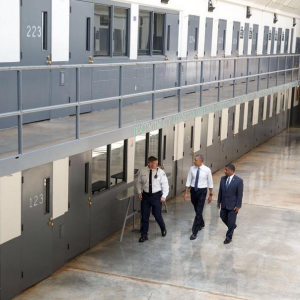During his campaign for president, Donald Trump’s talking points on crime and punishment harkened back to an era of “tough on crime” campaign rhetoric that fueled the stump speeches of candidates like Ronald Reagan and Bill Clinton.
Trump declared himself the “law and order” candidate and rang an alarm about a purported growing crime wave and chaotic inner cities. What he ignored was a two-decade drop in crime rates, along with the societal trauma caused by record-level incarceration and the disproportionate burden of criminalization on communities of color.
Barack Obama’s White House and Department of Justice have prioritized reducing excessive penalties for drug offenses, easing re-entry for people leaving imprisonment and rooting out racial disparity in the criminal justice system. During the final three years of his administration the federal prison population has declined by almost 28,000, following more than three decades of rising imprisonment. His final months in office have been punctuated with regular announcements of clemency for forgotten men and women serving long sentences for drug crimes, many originally destined to spend the rest of their lives in prison.
As this politically divided nation prepares for the transition of power to a new administration, President-elect Trump should take the time to talk to his Republican colleagues in Congress and in the states to review the national success story of criminal justice reform. Indeed, political leaders of both parties have embraced criminal justice reforms that could constitute the outlines of a national crime agenda.
In recent years America’s prison population has finally stabilized after nearly 40-years of unprecedented growth. Most states have seen declines in their prison populations because of policy reforms that curbed mandatory minimum sentences for low-level drug crimes, scaled back imprisonment for technical violations of parole and diverted small-time property and drug offenses from incarceration.
Four states — New Jersey, New York, Rhode Island and California — have seen prison population declines of more than 20 percent over the last 15 years with no adverse effect on public safety. Many states are now closing prisons instead of spending millions in taxpayer dollars to build more.
At the federal level where the president’s criminal justice authority is most relevant, bipartisan leaders in the Senate and House came together in the last year to endorse consensus-driven sentencing and corrections reform in an attempt to further reduce the significant overcrowding in federal prisons and establish a more equitable and proportional punishment system.
Senate Judiciary Chairman Chuck Grassley, R-Iowa, championed the Sentencing Reform and Corrections Act — the most significant criminal justice reform legislation of a generation as described by his Democratic colleague Dick Durbin of Illinois. Grassley oversaw passage of the bill that would reduce sentences for drug mandatory minimums, including for people serving life without parole, through his committee on a bipartisan vote. Grassley’s support for criminal justice reform was a dramatic reversal of position from earlier in 2015 when he called supporters of sentencing reform measures part of the “leniency industrial complex.”
Grassley’s conversion to reformer can be attributed to his moral understanding of justice, fairness, redemption and second chances, which he shares with fellow conservatives including Senate Majority Whip John Cornyn and House Speaker Paul Ryan as well as liberals Patrick Leahy and Durbin. While their commitment to criminal justice reform is not likely to fade, the question now becomes how will President-elect Trump and his attorney general nominee, Jeff Sessions, respond?
Trump’s elevation of Sessions certainly dims prospects for continuing the progress made by the current Department of Justice to reduce the federal prison population. Much of the decline can be attributed to agency directives that deprioritized prosecutions of street-level drug sellers in favor of high-level cases more appropriate for federal attention.
While this year Sessions led a small but vocal group of senators in opposing the bipartisan sentencing reform, in the recent past Sessions has favored sentencing reforms. In 2010, he negotiated enactment of the Fair Sentencing Act with Durbin to address the extreme racial disparity in crack cocaine sentencing. Advocates hope that this successful sentencing reform can serve as a model for the new administration.
Much has changed since the “get tough” atmosphere of the 1980s. Lawmakers in both parties now support evidence-based policies that promote public safety, value opportunities for redemption and are cost-effective. The incoming president and attorney general would be wise to build on these initiatives in the months and years ahead.

